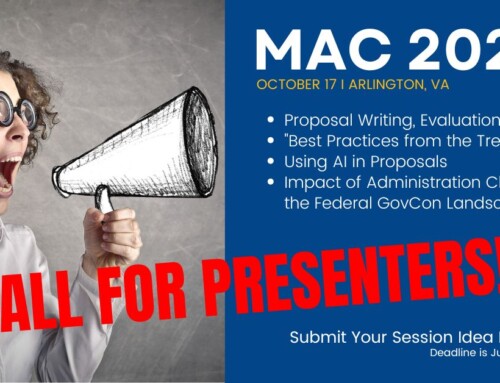Among the many informative sessions at last month’s APMP-NCA Mid-Atlantic Conference, one struck me as especially brilliant. It provided an elegant tool to take along to those client or potential client meetings to accomplish what you need. You know those meetings; when you finally get the attention of the buyer in your target agency, and you know that running through a boring capability briefing is an easy way to fill the time and satisfy yourself that you have done your job of making an impression. But then what? What have you really gained from a canned capabilities briefing? Most importantly, how do you follow up on the meeting? You have done your spiel and the listener will be polite and thank you for coming by, but what do you do now?
Well, my new capture hero, Mark Wigginton, with Focusing on Results has got a great tool for you: Seven Quality Questions that get the information you need.
Before I get to the questions, there it is important to understand the principles that make these questions powerful. And before I get to the principles, we all must admit and that what we are doing here is sales. We are acting as a salesman or woman for our company, and if you are like me, you really do not want to admit that you are involved in sales. (Its marketing, BD, capture, but NOT Sales!) Salespeople are connected in my mind with cheap and loud suits, an overbearing personality, and a desire to pressure someone to buy something that they don’t really want or need. I don’t want to be that person. I want to do great work and then let my reputation diffuse through the marketplace, so they come to me seeking out my product or service. If you and your company are in the place where all your work comes to you organically, congratulations to y’all. Unfortunately, for the rest of us we need to go out and convince people to buy our stuff, either because organic business growth is too slow, too small, or not resulting in the kind of deals that we want. If a company wants to move into a new space, it will require getting out and working the phones, setting up meetings and going through a process to convince people that your stuff meets their needs. And that gentle reader is sales.
Now on to how to do sales well. I have seen and others have affirmed that the most successful salespersons put the buyer at the center of all conversations. An effective sales call is when the seller engages the buyer in a conversation about needs to be met and then connecting those needs to offerings. That is the first principle of the 7 Questions: put the buyer in the spotlight and make the meeting about them and their needs. The second principal is that the conversation cannot be planned out by you the saleswo/man. It must be an open agenda which requires that the questions be open ended. Open ended questions cannot be answered with yes or no, or a list of choices rather they demand that the respondent share a more detailed perspective.

These details are what the seller can use to develop his/her approach to the product or service offering.
- Put the buyer in the spotlight
- Ask open ended questions
With that established, lets dive in!
Q1: What is on your mind? The first question throws the meeting over to the buyer. It invites them to tell you what is important to them right now. When I worked at Booz Allen 10 years ago, we used to joke about the canned sales call question “what is it that keeps you up at night?” that sales folk (like us) use to figure out client needs. I like What is on Your Mind because it feels more natural and less demanding while getting you to the same place. You may get an unhelpful response like “the upcoming election” or the “the war in Ukraine” but that is OK because you are establishing yourself as someone who wants to know what they care about. You can also get past a non-work answer with the second question.
Q2: And what else? Mark calls this the awesome question because it can be used at any time in the discussion to dig deeper on what your target is thinking about and what you might be able to do about it. If the answer is that the new director is pushing down a bunch of changes on us, or we are understaffed, or our budget just got cut; these start the conversation moving in a direction that is useful. The AWEsome question, And What Else, might get them to talk more about what the new director is pushing, how the budget cuts will affect programs they care about and so on. Mark advises that you use the AWEsome question no more than 2 or 3 time with an individual, maybe more if you have a group. Next, we work toward the meat of the matter.
Q3: What is the real challenge for you? Now we are asking our buyer to sort through all the concerns they may have mentioned, to get past the surface problems and get to the heart of the matter. This question has the most beloved word in the English language with respect to sales: You. In fact, 5 out of 7 of the questions contain you! For this conversation the objective is not to look at The Problem from the perspective of their boss (they cannot speak for their boss) or the agency, but how the problem is a concern for them in reaching some goal of theirs. Since buying decisions are group decisions, the problem this person has may not be the final determinant in making the purchase, but right now all we care about is one person and their concerns. We will weave all the concerns into a comprehensive solution later.
Once you are given the Real Problem for You, it is valuable to reflect it back to them, so they understand that you heard them. This also gives them a chance to clarify or elaborate on their initial enunciation of the problem. Once someone has shared something like the Real Problem and you make it clear that you understand that problem you have done a great deal to establish a connection and trust with the person you hope will be a buyer. The next question continues to focus specifically on your respondent and their view of the solution…
Q4: What do you want? This gives you listener the opportunity to talk about the desired end state. Where does s/he want to go? What will the future look like after the challenge is solved? We are not yet to the point of offering a solution but imagining the world once that solution has done its job and the problem has been solved. You might get, “Well, I don’t know” and one way to get past that is to ask them to “Imagine that you DID know, what would that be?” Once we both understand the desired end state the connection between now and then must be made so we can see how your company offering will fit in.
Q5: How Can I Help? Mark called this a lazy question; after all, shouldn’t we explain to THEM how we can help? We have a trick bag full of service or product offerings and isn’t it just a matter of reaching in there and choosing the right one for them to buy? No not really, because offering a solution now is taking the focus off them. While they may have shared a great deal up to know, you cannot possibly know everything you need to know about their organization to suggest a solution to their problem. After all what you propose may have already been tried or won’t work in their office for a reason that they have not yet shared. There may even be something simple that they need, and you might offer them something that doesn’t scratch that specific itch.
The next question was so brilliant that when I heard it the first time, I exclaimed from my seat. Mark calls this the strategic question, because everything about leading organizations is about making choices and trade-offs.
Q6: If you’re saying yes to this, what are you saying no to? How many times have you had one of these sales meetings that went great, and it seemed like you were moving the relationship in the right direction, and you had agreed on next steps, only to have all that good energy and progress evaporate later. Could it be that your target thought it was a great idea in the meeting but after further discussion with their team on how to apply your solution, it became clear that there were trade-offs involved. And the discussion of these trade-offs killed your idea. This question gets them thinking about the trade-offs while you are still in the room so you can talk them through how to handle them. What are the opportunity costs of this course?
The last question may seem irrelevant, but it is an excellent way to wrap up and summarize the meeting.

Q7: What was most useful for you? There is that word again, the You word. This gives your listener the chance to reflect on the discussion and provide comment on what went well or not. It also has the word “useful” in it, and by getting them to answer how this discussion was useful, it establishes you, the questioner as useful in some way. You are starting to become a resource simply by the questions you asked and drawing out of them critical problems, proposed solutions to them and answers to the strategic conundrums presented by implementing this solution.
These questions have their roots in two books on coaching and leadership:
Enlightened Leadership: Getting to the Heart of Change by Ed Oakley and Doug Krug
The Coaching Habit: Say Less, Ask More & Change the Way You Lead Forever by Michael Bungay Stanier
Original article published on ZK Development’s website, reprinted here with permission: https://www.zk-development.com/blog/2022/11/11/7-quality-questions-for-sales-calls






Leave A Comment